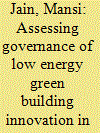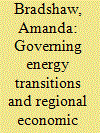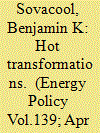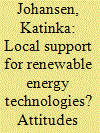|
|
|
Sort Order |
|
|
|
Items / Page
|
|
|
|
|
|
|
| Srl | Item |
| 1 |
ID:
168324


|
|
|
|
|
| Summary/Abstract |
In order to support transitions away from open-fire cooking and toward cleaner household energy systems, a better understanding of users’ technology adoption patterns and preferences is needed. This paper highlights key factors influencing use of two types of biomass-burning stoves provided through the REACCTING (Research on Emissions, Air quality, Climate, and Cooking Technology in Northern Ghana) randomized intervention study. We examine traditional and improved stove use over a two year follow up period, finding that the more basic rocket stove was used at a higher rate than the higher-tech gasifier stove. While stove use patterns varied by stove group, region, primary cook occupation, and socioeconomic status, use of traditional stoves remained high across most groups. Users perceived that improved stoves were less suitable for cooking a staple dish, Tuo Zaafi (TZ), and technical problems (e.g., battery failures with the gasifier stove) also limited the effectiveness of the intervention. Moving forward, household energy policies should prioritize a range of technologies that have potential to meet local needs while delivering meaningful health and/or environmental benefits, recognizing that stove and fuel “stacking” is likely to persist. A greater focus on markets and enabling environments is needed to support sustainable and scalable energy transitions.
|
|
|
|
|
|
|
|
|
|
|
|
|
|
|
|
| 2 |
ID:
174990


|
|
|
|
|
| Summary/Abstract |
This paper explores the governance of sectoral innovation and niche formation of green buildings and other low energy buildings (like NZEBs). Two analytical frameworks are used and synthesized: the Sectoral Systems Innovation Assessment framework (SSIAf) and the Governance Assessment Tool (GAT). The key components of the former are: shaping of expectations, actor network formation, institutions, learning process, and stimulating market demand. The SSIAf components are then assessed against the four quality criterions of the GAT framework, i.e. extent, coherence, flexibility, and intensity. The research design presented in this paper applies the analytical framework developed to case studies of two cities: Singapore and Delhi. Data collection involved participant observation and expert interviews. The results of the study reveal that the overall governance conditions in Singapore are fairly strong and highly supported by the government, unlike Delhi where governance quality was found to lack coherence and intensity, and can be considered only moderately supportive to green building innovations. The results also reveal the role of government actors in steering the energy transformation process in building sector. The analytical framework developed in this paper can be further elaborated, also as a potential policy tool to support cities in managing energy system innovations like energy infrastructures, smart grids or community energy storage in diverse and complex urban settings.
|
|
|
|
|
|
|
|
|
|
|
|
|
|
|
|
| 3 |
ID:
176716


|
|
|
|
|
| Summary/Abstract |
This article contributes to the recent scholarly attempts towards bridging different energy studies perspectives in explaining the change of energy systems. Informed by political, socio-technical and techno-economic perspectives on energy transitions, we focus on explaining the divergent solar and wind power deployment rates across six Central and Eastern European countries. We suggest and test the proposition that the interplay of four key factors has shaped this development: state capacities, relations with Russia, technological lockin and electricity import dependency. We find that the countries relations towards Russia, the level of nuclear power lock-in and the state intervention in the energy sector have been instrumental in affecting the adoption of wind and solar power. The integrated framework and the findings presented in the article should encourage future energy transition research to capture and trace the interplay among different factors in an integrated and comparable manner.
|
|
|
|
|
|
|
|
|
|
|
|
|
|
|
|
| 4 |
ID:
180860


|
|
|
|
|
| Summary/Abstract |
This paper explores the history of wind power technologies and the integration of wind energy in the Danish energy system. It does so focusing particularly on historical events, socio-cultural and socio-political changes and priorities that were important on this technological journey. From the first primitive wind turbines in the late 1800s, to the world wars, through the energy- crisis in the 70s, and into the decades of growing environmental awareness and concern, this historical account describes how policy priorities in Denmark gradually translated from the focus on energy diversification, energy efficiency and energy independence to the focus on sustainability and renewable energy resources, with wind energy and wind power technologies at the top of the priority list. Historically, wind power has been - and it still is - popular in Denmark. However, as the modern wind power turbines gradually grew to industrial scale heights, unchallenged support for specific local wind farms could no longer be taken for granted. This paper also touches upon the frequently tacit dilemmas of renewable energy technology planning and deployment, for example issues of environmental justice, wind farm ownership structures, and the role of social psychology for low-carbon energy transition processes. Notably, attention is drawn to the representation biases that may result in the emphasis of wind farm opposition / grievances in the wider wind farm related debates, where resistance to local wind farm projects might derive from minority opposition groups. Insights and lessons learnt from this Danish history of wind power may prove valuable and inspirational for other countries engaging in low-carbon energy transitions.
|
|
|
|
|
|
|
|
|
|
|
|
|
|
|
|
| 5 |
ID:
187599


|
|
|
|
|
| Summary/Abstract |
Energy transitions require engagement with users, local communities and wider publics in order to be fair, acceptable and, ultimately, successful. Here we focus on the development of decentralised energy systems instigated by central government. Smart Local Energy Systems (SLES), involving low carbon generation, demand sources and smart technologies in a geographically-bounded location, are important but unexplored contexts for public engagement. Drawing on 23 interviews with partner organisations in 12 UK SLES projects, we investigate the targets, methods and rationales of engagement. Partners engage a range of user and community groups around multiple energy system components using a variety of methods, directly and via intermediary organisations. Project size is not a major influence on breadth and intensity of engagement. Project partners rationalise practices with reference to characterisations of users and engagement, and practices are conditioned by a range of factors (e.g. technological boundaries, place, partners involved, and the wider organisational context within which SLES projects take place). We highlight a need for future SLES policy to emphasise engagement as a key facet, institute systematic social learning between SLES projects, and consider how to engage publics beyond the boundaries of individual projects.
|
|
|
|
|
|
|
|
|
|
|
|
|
|
|
|
| 6 |
ID:
116701


|
|
|
|
|
| Publication |
2012.
|
| Summary/Abstract |
The purpose of this paper is to understand the long run demand for energy-related environmental quality, its influence on legislation and on transitions to low polluting energy sources. It presents a series of episodes in British history where a demand for improvements in energy-related environmental quality existed. These episodes helped to identify a few cases where markets partially drove transitions to low polluting energy sources, in specific economic conditions. More generally, they showed that, when pushed, governments will introduce environmental legislation, although it tends to be weak and poorly enforced. In the case of air pollution, strong and binding legislation occurred roughly one hundred years later than was socially optimal. Based on this evidence, for a transition to a low carbon economy, governments will probably need to introduce focussed and binding legislation, and this cannot be expected without strong and sustained demand for climate stability. This demand will need to be spearheaded by pressure groups to introduce legislation, to enforce it and to avoid it being over-turned by future governments.
|
|
|
|
|
|
|
|
|
|
|
|
|
|
|
|
| 7 |
ID:
111069


|
|
|
|
|
| Publication |
2012.
|
| Summary/Abstract |
Very little work has been done so far to model, test, and understand the relationship between oil prices and EROI over time. This paper investigates whether a declining EROI is associated with an increasing oil price and speculates on the implications of these results on oil policy. A model of the relationship between EROI and oil market prices was developed using basic economic and physical assumptions and non-linear least-squares regression models to correlate oil production price with EROI using available data from 1954-1996. The model accurately reflects historical oil prices (1954-1996), and it correlates well with historical oil prices (1997-2010) if a linear extrapolation of EROI decline is assumed. As EROI declines below 10, highly non-linear oil price movements are observed. Increasing physical oil scarcity is already providing market signals that would stimulate a transition away from oil toward alternative energy sources. But, price signals of physical oil scarcity are not sufficient to guarantee smooth transitions to alternative fuel sources, especially when there is insufficient oil extraction technology development, a declining mark-up ratio, a non-linear EROI-cost of production relationship, and a non-linear EROI-price relationship.
|
|
|
|
|
|
|
|
|
|
|
|
|
|
|
|
| 8 |
ID:
137718


|
|
|
|
|
| Summary/Abstract |
The prevalent theories in the debate on sustainability transitions have been criticised for not sufficiently addressing energy change processes at the local level. This paper aims to enhance our understanding of local energy reorganisation processes. Drawing on the Regional Innovation Systems (RIS) approach, we argue that local development dynamics result from the interaction of various subsystems: science, politics, public administration, industry, finance, intermediaries and civil society. The analysis of the involved subsystems and their interaction shows how energy transitions are shaped by different individual and organisational actors as well as institutions on the local level. Empirical evidence from case studies on the German cities of Emden and Bottrop illustrates our theoretical conceptualisation of energy transitions. We conclude by presenting characteristic interaction patterns for energy transition drawn from the two cases.
|
|
|
|
|
|
|
|
|
|
|
|
|
|
|
|
| 9 |
ID:
116689


|
|
|
|
|
| Publication |
2012.
|
| Summary/Abstract |
This short essay first reviews the pioneers of energy transition research both in terms of data as well as theories. Three major insights that have emerged from this nascent research fields are summarized highlighting the importance of energy end-use and services, the lengthy process of transitions, as well as the patterns that characterize successful scale up of technologies and industries that drive historical energy transitions. The essay concludes with cautionary notes also derived from historical experience. In order to trigger a next energy transition policies and innovation efforts need to be persistent and continuous, aligned, as well as balanced. It is argued that current policy frameworks in place invariably do not meet these criteria and need to change in order to successfully trigger a next energy transition towards sustainability.
|
|
|
|
|
|
|
|
|
|
|
|
|
|
|
|
| 10 |
ID:
111068


|
|
|
|
|
| Publication |
2012.
|
| Summary/Abstract |
Policies to address climate change by reducing greenhouse gas emissions might be made more effective if we can better understand the pathways by which transformative technologies become significant components of energy systems. Indeed, the central question of mitigation revolves around the scope of policy to influence or accelerate the diffusion of low-carbon technology. While market forces clearly influence technology deployment, understanding the longer-term and large-scale changes in the energy system requires a broader understanding of the relative influence of institutional, behavioral, and social factors. This paper presents the results of an interview-based, comparative case approach to investigating systematically the relative importance of these non-economic factors influencing technological change across technology and country contexts. We identified two low-carbon energy sectors (bioenergy and nuclear power) that underwent significant changes over the past 50 years in the energy portfolio of three countries: Brazil, Sweden, and the United States. We identified nine categories of factors that might contribute to these large technological transformations, and then evaluated, via interviews with sector participants in each country, which factors were viewed as being determinative or highly influential in the trajectory of that technology in their country context. We also draw out policy implications and directions for future research.
|
|
|
|
|
|
|
|
|
|
|
|
|
|
|
|
| 11 |
ID:
112714


|
|
|
|
|
| Publication |
Cambridge, MIT Press, 2008.
|
| Description |
xi, 307p.
|
| Contents |
Includes bibliographical references and index.
|
| Standard Number |
9780262195867
|
|
|
|
|
|
|
|
|
|
|
|
Copies: C:1/I:0,R:0,Q:0
Circulation
| Accession# | Call# | Current Location | Status | Policy | Location |
| 054389 | 363.34/SMI 054389 | Main | On Shelf | General | |
|
|
|
|
| 12 |
ID:
163562


|
|
|
|
|
| Summary/Abstract |
States, regions, and municipalities have a growing importance in innovating policies to promote renewable sources of energy. This article examines the contribution of three state governments in developing and deploying wind and solar energy technologies in Brazil. The Brazilian electricity sector represents an interesting case of a middle-income country that is distinguished by strong federal involvement in energy governance and a reliance on hydroelectric power, followed by natural gas and coal. Using interviews conducted with policymakers and energy professionals, we find that regional energy transitions emerge as part of a process where state-level actors frame renewable energy choices primarily in terms of economic development opportunities and improving energy security. The engagement of regional institutions and organizations with energy priorities further influences the development of renewable technologies. The main policy implication is that state governments can have a strong role in the learning and niche formation of renewable alternatives that have been given less priority at the national level. This paper concludes that future policies should investigate how to scale up state renewable energy programs and initiatives.
|
|
|
|
|
|
|
|
|
|
|
|
|
|
|
|
| 13 |
ID:
176711


|
|
|
|
|
| Summary/Abstract |
The rapid decarbonisation of heat remains a challenging energy and climate policy priority. In this study, after screening 461 global case studies, we examine four national household transitions in heat, and examine their implications for governance. These transitions were both rapid, involving transformations in heat provision in a short timeframe of 18–35 years; and deep, involving diffusion that collectively reached more than 100 million households and more than 310 million people. From 1995 to 2015, China stimulated industrial research with strong municipal and national targets and policies to the point where they saw adoption rates for solar thermal systems surpass 95% market penetration in many urban areas. From 1976 to 2011, Denmark blended small-scale decentralized community control with national standards and policies to promote district heating so it reached 80% of household needs. From 2000 to 2018, Finland harnessed user and peer-to-peer learning, and innovation, alongside national and European policies and incentives so that heat pumps reached almost a third of all homes. From 1960 to 1977, The United Kingdom coordinated a nationalized Gas Council and Area Boards with industry groups, appliance manufacturers, installers and marketing campaigns so that gas central heating reached almost half of all homes. These four rapid case studies share commonalities in polycentric governance, rooted in (1) equity, (2) inclusivity, (3) information and innovation, (4) ownership and accountability, (5) organizational multiplicity, and (6) experimentation and flexibility. The study affirms that designing the right sort of political and governance architecture can be just as salient as technical innovation and development in stimulating transitions.
|
|
|
|
|
|
|
|
|
|
|
|
|
|
|
|
| 14 |
ID:
176712


|
|
|
|
|
| Summary/Abstract |
The rapid decarbonisation of heat remains a challenging energy and climate policy priority. In this study, after screening 461 global case studies, we examine four national household transitions in heat, and examine their implications for governance. These transitions were both rapid, involving transformations in heat provision in a short timeframe of 18–35 years; and deep, involving diffusion that collectively reached more than 100 million households and more than 310 million people. From 1995 to 2015, China stimulated industrial research with strong municipal and national targets and policies to the point where they saw adoption rates for solar thermal systems surpass 95% market penetration in many urban areas. From 1976 to 2011, Denmark blended small-scale decentralized community control with national standards and policies to promote district heating so it reached 80% of household needs. From 2000 to 2018, Finland harnessed user and peer-to-peer learning, and innovation, alongside national and European policies and incentives so that heat pumps reached almost a third of all homes. From 1960 to 1977, The United Kingdom coordinated a nationalized Gas Council and Area Boards with industry groups, appliance manufacturers, installers and marketing campaigns so that gas central heating reached almost half of all homes. These four rapid case studies share commonalities in polycentric governance, rooted in (1) equity, (2) inclusivity, (3) information and innovation, (4) ownership and accountability, (5) organizational multiplicity, and (6) experimentation and flexibility. The study affirms that designing the right sort of political and governance architecture can be just as salient as technical innovation and development in stimulating transitions.
|
|
|
|
|
|
|
|
|
|
|
|
|
|
|
|
| 15 |
ID:
127297


|
|
|
|
|
| Publication |
2014.
|
| Summary/Abstract |
This article employs the multi-level perspective on socio-technical transitions to explore the historical evolution of the electricity regime in the province of Ontario from 1885-2013 and to interpret the potential for future movement towards decarbonization. With an emphasis on the political and social dimensions of transitions, this analysis traces the key features influencing change within Ontario's electricity system over the past century. This paper uses multiple criteria (the phase of electrification; role of the electricity system in economic development; structures of ownership, market and regulation; dominant technologies; and the relative stability of arrangements) to characterize distinct regime configurations and periods of instability which separate relatively stable system orientations. Lessons are drawn from the historical case with implications for future decarbonization in the province, including the importance of: (1) residual momentum; (2) embedded guiding principles; and, (3) Politico-Economic Coalitions.
|
|
|
|
|
|
|
|
|
|
|
|
|
|
|
|
| 16 |
ID:
176860


|
|
|
|
|
| Summary/Abstract |
Within Canada, Mexico or the United States, policy-making organizations are evaluating energy markets and energy trade within their own borders often by ignoring how these countries’ energy systems are integrated with each other. These analytical gaps provided the main motivation for the Energy Modeling Forum (EMF) 34 study on North American energy integration and trade. This paper compares North American results from 17 models and discusses their policy motivation. Oil and natural gas production in the three major countries are modestly sensitive to crude oil and natural gas price changes, although these elasticities are below unity. Carbon taxes displace coal and some natural gas with renewables within all three power markets. Lower natural gas prices replace coal and some renewables with natural gas within electric generation. Higher intermittent renewable penetration in the power sector displaces coal and some natural gas. A key conclusion is that much remains to be done in integrating future analyses and in sharing and improving the quality and consistency of the underlying data.
|
|
|
|
|
|
|
|
|
|
|
|
|
|
|
|
| 17 |
ID:
181775


|
|
|
|
|
| Summary/Abstract |
Grid resilience and reliability are pivotal in the transition to low and zero carbon energy systems. Tree-trimming operations (TTOs) have become a pivotal tool for increasing the resilience power grids, especially in highly forested regions. Building on recent literature, we aim at assessing the temporal and spatial extents of the benefits that TTOs produce on the grid from three perspectives: the frequency, extent, and duration of outages. We use a unique dataset provided by Eversource Energy, New England's largest utility company, with outage events from 2009 to 2015. We employ spatial econometrics to investigate both the legacy and spatial extent of TTOs. Our results show TTOs benefits occur for all three metrics for at least 4 years, and benefits spillover to up to 2 km throughout the treated areas, with significant spatial spillovers across the state greater than direct effects. Implications lead to supporting TTOs as part of the hardening policies for utility companies, especially as home-based activities increase in importance in a post-COVID19 world.
|
|
|
|
|
|
|
|
|
|
|
|
|
|
|
|
| 18 |
ID:
166973


|
|
|
|
|
| Summary/Abstract |
This paper documents different attitudes towards local renewable energy technology (RET) projects in Denmark among two key RET stakeholder groups, permanent area residents (PRs) and second home owners (SHOs). It does so via survey data collected from almost 2000 respondents during a Danish near-shore wind farm tender. Judging by this data, local PRs are positive towards the planned local RETs, while SHOs are less so. This emphasizes that potential RET project stakeholders and stakeholder groups may have very different RET project perceptions and opinions. The planned RET projects were subject to widespread critique in the public and political RET project related debate, but the documented PR RET project support was rather silent support. This is a noteworthy inconsistency calling for further research. Drawing upon research insights from the interdisciplinary socially focused energy transitions body of literature, the paper suggests that particular uses of and attachments to particular places may inform stakeholder perceptions of RET related local change. The research findings have significant implications for RET planning, practice and policy more broadly.
|
|
|
|
|
|
|
|
|
|
|
|
|
|
|
|
| 19 |
ID:
177387


|
|
|
|
|
| Summary/Abstract |
The increasing penetration of microgrids in appears to be part of a transition toward electricity distribution systems that are more decentralized than the current system. With microgrids gaining space as a competing and parallel distribution grid model and challenging the current centralized grid system, studying their adoption presents an opportunity to understand this socio-technical transition in the energy system. This study looks at this ongoing change in the United States and applies the Multi-Level Perspective framework to explore the drivers, contexts, processes, policies, institutions, and interactions that affect the adoption of microgrids. Through a qualitative case study analysis of California, New York, and Oregon, the study finds that natural disasters, massive power outages and climate change concerns have acted as key pressures for the adoption of microgrids. At the same time, the electric power system maintains important stabilization mechanisms, such as the availability of cheap and abundant electricity, as well a market structure that limits the opportunities of entry and profit for third-party developers, which make it harder for niche innovations like microgrids to break in. In addition, this study finds that state support in the form of funding and legislation is crucial for nurturing the microgrid niche market.
|
|
|
|
|
|
|
|
|
|
|
|
|
|
|
|
| 20 |
ID:
171504


|
|
|
|
|
| Summary/Abstract |
This article evaluates the opportunities and limitations of network governance to support low-carbon energy transitions in European cities. Network visualization and statistical measures of network structure are combined with qualitative case study data to provide a comparative analysis of energy transition networks in Birmingham, Budapest and Frankfurt. Data reveal that existing networks differ in extent, integration and distribution of authority. Contextual characteristics help explain these differences, highlighting the importance of path dependencies and disjunctions in each city. These findings represent important considerations for the Transition Management model which aims specifically at governing sustainability transitions via network governance. Responding to a gap in the literature we demonstrate that Transition Management must be considered as an intervention into locationally specific settings and existing networks. The design of network structures and processes, as well as role of any ‘transition manager’, must reflect contextual factors and existing network considerations. Failure to account for contextual differences limits the model’s capacity to contribute to sustainable energy transitions in different cities.
|
|
|
|
|
|
|
|
|
|
|
|
|
|
|
|
|
|
|
|
|